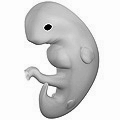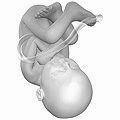Reproductive Health

Pregnancy is the carrying of one or more offspring, known as a fetus or embryo, inside the uterus of afemale. In a pregnancy, there can be multiple gestations, as in the case of twins or triplets. Human pregnancy is the most studied of all mammalian pregnancies. Obstetrics is the surgical field that studies and cares for high risk pregnancy.Midwifery is the non-surgical field that cares for pregnancy and pregnant women.
Childbirth usually occurs about 38 weeks after fertilization(conception), i.e., approximately 40 weeks from the last normal menstrual period (LNMP) in humans. The date of delivery is considered normal medically if it falls within two weeks of the calculated date. The calculation of this date involves the assumption of a regular 28-day period. Thus, pregnancy lasts almost nine months.
The exact definition of the English word “pregnancy” is a subject of political controversy, but it is not a matter of substantial controversy in the medical community.
Terminology
One scientific term for the state of pregnancy is gravid, and a pregnant female is sometimes referred to as a gravida. Neither word is used in common speech. Similarly, the term "parity" (abbreviated as "para") is used for the number of previous successful live births. Medically, a woman who has never been pregnant is referred to as a "nulligravida", and in subsequent pregnancies as "multigravida" or "multiparous". Hence during a second pregnancy a woman would be described as "gravida 2, para 1" and upon delivery as "gravida 2, para 2". Incomplete pregnancies of abortions, miscarriages or stillbirths account for parity values being less than the gravida number, whereas a multiple birth will increase the parity value. Women who have never carried a pregnancy achieving more than 20 weeks of gestation age are referred to as "nulliparous".
The term embryo is used to describe the developing offspring during the first eight weeks following conception, and the term fetus is used from about two months of development until birth.
In many societies' medical or legal definitions, human pregnancy is somewhat arbitrarily divided into three trimester periods, as a means to simplify reference to the different stages of prenatal development. The first trimester carries the highest risk of miscarriage (natural death of embryo or fetus). During the second trimester, the development of the fetus can be more easily monitored and diagnosed. The beginning of the third trimester often approximates the point of viability, or the ability of the fetus to survive, with or without medical help, outside of the uterus.
Initiation and duration
Pregnancy occurs as the result of the female gamete or oocyte being penetrated by the male gamete spermatozoon in a process referred to, in medicine, as "fertilization", or more commonly known as "conception". After the point of "fertilization" it is referred to as an egg. The fusion of male and female gametes usually occurs through the act of sexual intercourse. However, the advent ofartificial insemination and in vitro fertilisation have also made achieving pregnancy possible in cases where sexual intercourse does not result in fertilization (e.g. through choice or male/femaleinfertility).
The expected date of delivery (EDD) is 40 weeks counting from the last menstrual period (LMP) and birth usually occurs between 37 and 42 weeks, The actual pregnancy duration is typically 38 weeks after conception. Though pregnancy begins at conception, it is more convenient to date from the first day of a woman's last menstrual period, or from the date of conception if known. Starting from one of these dates, the expected date of delivery can be calculated. 40 weeks is nine months and six days, which forms the basis of Naegele's rule for estimating date of delivery. More accurate and sophisticated algorithms take into account other variables, such as whether this is the first or subsequent child (i.e. pregnant woman is a primip or a multip, respectively), ethnicity, parental age, length of menstrual cycle and menstrual regularity.
Pregnancy is considered 'at term' when gestation attains 37 complete weeks but is less than 42 (between 259 and 294 days since LMP). Events before completion of 37 weeks (259 days) are considered pre-term; from week 42 (294 days) events are considered post-term. When a pregnancy exceeds 42 weeks (294 days), the risk of complications for woman and fetus increases significantly. As such, obstetricians usually prefer to induce labour, in an uncomplicated pregnancy, at some stage between 41 and 42 weeks.
Recent medical literature prefers the terminology pre-term and post-term to premature and post-mature. Pre-term and post-term are unambiguously defined as above, whereas premature andpostmature have historical meaning and relate more to the infant's size and state of development rather than to the stage of pregnancy.
Fewer than 5% of births occur on the due date; 50% of births are within a week of the due date, and almost 90% within two weeks. It is much more useful, therefore, to consider a range of due dates, rather than one specific day, with some online due date calculators providing this information.
Accurate dating of pregnancy is important, because it is used in calculating the results of variousprenatal tests (for example, in the triple test). A decision may be made to induce labour if a fetus is perceived to be overdue. Furthermore, if LMP and ultrasound dating predict different respective due dates, with the latter being later, this might signify slowed fetal growth and therefore require closer review.
Diagnosis
The beginning of pregnancy may be detected in a number of different ways, either by a pregnant woman without medical testing, or by using medical tests with or without the assistance of a medical professional.
A number of early medical signs are associated with pregnancy. These signs typically appear, if at all, within the first few weeks after conception. Although not all of these signs are universally present, nor are all of them diagnostic by themselves, taken together they make a presumptive diagnosis of pregnancy. These signs include the presence of human chorionic gonadotropin (hCG) in the blood and urine, missed menstrual period, implantation bleeding that occurs at implantation of the embryo in the uterus during the third or fourth week after last menstrual period, increased basal body temperature sustained for over two weeks after ovulation,Chadwick's sign (darkening of the cervix, vagina, and vulva), Goodell's sign (softening of the vaginal portion of the cervix), Hegar's sign (softening of the uterus isthmus), and pigmentation of linea alba -Linea nigra, (darkening of the skin in a midline of the abdomen, caused by hyperpigmentationresulting from hormonal changes, usually appearing around the middle of pregnancy).
Pregnancy detection can be accomplished using one or more of various pregnancy tests which detect hormones generated by the newly-formed placenta. Clinical blood and urine tests can detect pregnancy soon after implantation, which is as early as 6-8 days after fertilization. Blood pregnancy tests are more accurate than urine tests. Home pregnancy tests are personal urine tests, which normally cannot detect a pregnancy until at least 12-15 days after fertilization. Both clinical and home tests can only detect the state of pregnancy, and cannot detect the age of the embryo.
In the post-implantation phase, the blastocyst secretes a hormone named human chorionic gonadotropin which in turn, stimulates the corpus luteum in the woman's ovary to continue producing progesterone. This acts to maintain the lining of the uterus so that the embryo will continue to be nourished. The glands in the lining of the uterus will swell in response to the blastocyst, and capillaries will be stimulated to grow in that region. This allows the blastocyst to receive vital nutrients from the woman.
Despite all the signs, some women may not realize they are pregnant until they are quite far along in their pregnancy, in some cases not even until they begin labour. This can be caused by many factors, including irregular periods (quite common in teenagers), certain medications (not related to conceiving children), and obese women who disregard their weight gain. Others may be in denial of their situation.
An early sonograph can determine the age of the pregnancy fairly accurately. In practice, doctorstypically express the age of a pregnancy (i.e. an "age" for an embryo) in terms of "menstrual date" based on the first day of a woman's last menstrual period, as the woman reports it. Unless a woman's recent sexual activity has been limited, or she has been charting her cycles, or the conception is as the result of some types of fertility treatment (such as IUI or IVF) the exact date of fertilization is unknown. Absent symptoms such as morning sickness, often the only visible sign of a pregnancy is an interruption of her normal monthly menstruation cycle, (i.e. a "late period"). Hence, the "menstrual date" is simply a common educated estimate for the age of a fetus, which is an average of two weeks later than the first day of the woman's last menstrual period. The term "conception date" may sometimes be used when that date is more certain, though even medical professionals can be imprecise with their use of the two distinct terms. The due date can be calculated by using Naegele's rule. The expected date of delivery may also be calculated fromsonogram measurement of the fetus. This method is slightly more accurate than methods based on LMP. The beginning of labour, which is variously called confinement or childbed, begins on the day predicted by LMP 3.6% of the time and on the day predicted by sonography 4.3% of the time.
Diagnostic criteria are: Women who have menstrual cycles and are sexually active, a period delayed by a few days or weeks is suggestive of pregnancy; elevated B-hcG to around 100,000 mIU/mL by 10 weeks of gestation.
Physiology
First trimester
Second trimester

Months 4 through 6 of the pregnancy are called the second trimester. Most women feel more energized in this period, and begin to put on weight as the symptoms of morning sickness subside and eventually fade away.
In the 20th week the uterus, the muscular organ that holds the developing fetus, can expand up to 20 times its normal size during pregnancy.
Although the fetus begins moving and takes a recognizable human shape during the first trimester, it is not until the second trimester that movement of the fetus, often referred to as "quickening", can be felt. This typically happens in the fourth month, more specifically in the 20 to 21 week, or by the 19th week if the woman has been pregnant before. However, it is not uncommon for some women to not feel the fetus move until much later. The placenta is now fully functioning and the fetus is making insulin and urinating. The reproductive organs distinguish the fetus as male or female.
Third trimester

Final weight gain takes place, which is the most weight gain throughout the pregnancy. The fetus will be growing the most rapidly during this stage, gaining up to 28g per day. The woman's belly will transform in shape as the belly drops due to the fetus turning in a downward position ready for birth. During the second trimester, the woman's belly would have been very upright, whereas in the third trimester it will drop down quite low, and the woman will be able to lift her belly up and down. The fetus begins to move regularly, and is felt by the woman. Fetal movement can become quite strong and be disruptive to the woman. The woman's navel will sometimes become convex, "popping" out, due to her expanding abdomen. This period of her pregnancy can be uncomfortable, causing symptoms like weak bladder control and back-ache. Movement of the fetus becomes stronger and more frequent and via improved brain, eye, and muscle function the fetus is prepared for ex uteroviability. The woman can feel the fetus "rolling" and it may cause pain or discomfort when it is near the woman's ribs and spine.
It is during this time that a baby born prematurely may survive. The use of modern medical intensive care technology has greatly increased the probability of premature babies surviving, and has pushed back the boundary of viability to much earlier dates than would be possible without assistance. In spite of these developments, premature birth remains a major threat to the fetus, and may result in ill-health in later life, even if the baby survives.
Prenatal development and sonograph images









